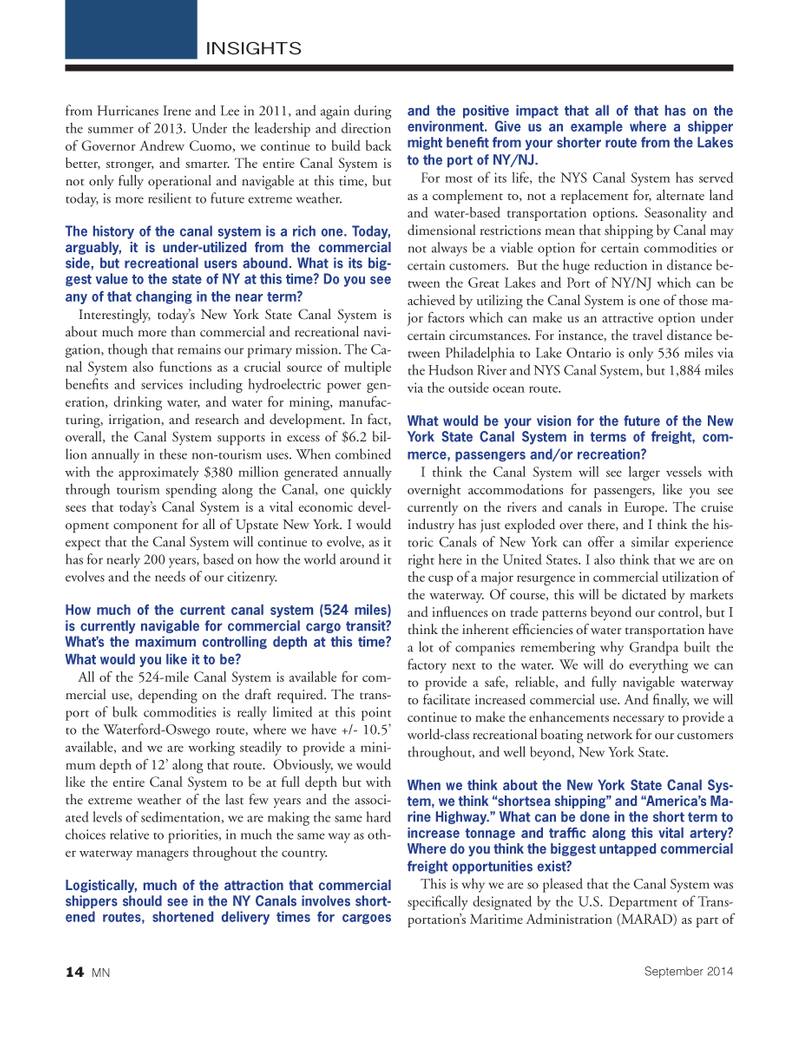
Page 14: of Marine News Magazine (September 2014)
Inland Waterways
Read this page in Pdf, Flash or Html5 edition of September 2014 Marine News Magazine
from Hurricanes Irene and Lee in 2011, and again during the summer of 2013. Under the leadership and direction of Governor Andrew Cuomo, we continue to build back better, stronger, and smarter. The entire Canal System is not only fully operational and navigable at this time, but today, is more resilient to future extreme weather. The history of the canal system is a rich one. Today, arguably, it is under-utilized from the commercial side, but recreational users abound. What is its big- gest value to the state of NY at this time? Do you see any of that changing in the near term?Interestingly, today?s New York State Canal System is about much more than commercial and recreational navi- gation, though that remains our primary mission. The Ca- nal System also functions as a crucial source of multiple bene ts and services including hydroelectric power gen- eration, drinking water, and water for mining, manufac- turing, irrigation, and research and development. In fact, overall, the Canal System supports in excess of $6.2 bil- lion annually in these non-tourism uses. When combined with the approximately $380 million generated annually through tourism spending along the Canal, one quickly sees that today?s Canal System is a vital economic devel- opment component for all of Upstate New York. I would expect that the Canal System will continue to evolve, as it has for nearly 200 years, based on how the world around it evolves and the needs of our citizenry. How much of the current canal system (524 miles) is currently navigable for commercial cargo transit? What?s the maximum controlling depth at this time? What would you like it to be?All of the 524-mile Canal System is available for com- mercial use, depending on the draft required. The trans- port of bulk commodities is really limited at this point to the Waterford-Oswego route, where we have +/- 10.5? available, and we are working steadily to provide a mini- mum depth of 12? along that route. Obviously, we would like the entire Canal System to be at full depth but with the extreme weather of the last few years and the associ- ated levels of sedimentation, we are making the same hard choices relative to priorities, in much the same way as oth- er waterway managers throughout the country. Logistically, much of the attraction that commercial shippers should see in the NY Canals involves short- ened routes, shortened delivery times for cargoes and the positive impact that all of that has on the environment. Give us an example where a shipper might bene t from your shorter route from the Lakes to the port of NY/NJ. For most of its life, the NYS Canal System has served as a complement to, not a replacement for, alternate land and water-based transportation options. Seasonality and dimensional restrictions mean that shipping by Canal may not always be a viable option for certain commodities or certain customers. But the huge reduction in distance be- tween the Great Lakes and Port of NY/NJ which can be achieved by utilizing the Canal System is one of those ma- jor factors which can make us an attractive option under certain circumstances. For instance, the travel distance be- tween Philadelphia to Lake Ontario is only 536 miles via the Hudson River and NYS Canal System, but 1,884 miles via the outside ocean route. What would be your vision for the future of the New York State Canal System in terms of freight, com- merce, passengers and/or recreation? I think the Canal System will see larger vessels with overnight accommodations for passengers, like you see currently on the rivers and canals in Europe. The cruise industry has just exploded over there, and I think the his- toric Canals of New York can offer a similar experience right here in the United States. I also think that we are on the cusp of a major resurgence in commercial utilization of the waterway. Of course, this will be dictated by markets and in uences on trade patterns beyond our control, but I think the inherent ef ciencies of water transportation have a lot of companies remembering why Grandpa built the factory next to the water. We will do everything we can to provide a safe, reliable, and fully navigable waterway to facilitate increased commercial use. And nally, we will continue to make the enhancements necessary to provide a world-class recreational boating network for our customers throughout, and well beyond, New York State. When we think about the New York State Canal Sys- tem, we think ?shortsea shipping? and ?America?s Ma- rine Highway.? What can be done in the short term to increase tonnage and traf c along this vital artery? Where do you think the biggest untapped commercial freight opportunities exist? This is why we are so pleased that the Canal System was speci cally designated by the U.S. Department of Trans- portation?s Maritime Administration (MARAD) as part of INSIGHTS14 MNSeptember 2014MN Sept14 Layout 1-17.indd 14MN Sept14 Layout 1-17.indd 148/20/2014 11:46:15 AM8/20/2014 11:46:15 AM

 13
13

 15
15
